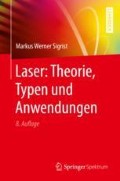Zusammenfassung
In diesem Kapitel werden die wichtigsten Aspekte bezüglich Sicherheit von Laser-Einrichtungen diskutiert. Aufgrund der hohen Kohärenz des Laserlichtes (s. Abschn. 2.2) können schon geringe Leistungen im mW Bereich gefährlich sein. Gefährdet sind insbesondere die Augen, bei hohen Leistungen aber auch die Haut. Für das sichere Arbeiten mit Lasern gilt es daher Gesetze und Verordnungen zu beachten. Die Laser werden aufgrund ihrer Gefährdung in 7 Klassen eingeteilt. Die Laser müssen entsprechend gekennzeichnet sein. Je nachdem müssen Laserschutzbrillen getragen, ein Laserbereich festgelegt und ein Laserschutzbeauftragter bestimmt werden. Im Folgenden werden die Gefährdung, die Laserklassifizierung und die Schutzmaßnahmen einzeln besprochen.
Access this chapter
Tax calculation will be finalised at checkout
Purchases are for personal use only
Literatur
EN (Europäische Normen), publiziert durch CENELEC (Commission Européenne Normalisation Electrotechnique), EN 60825-1, Ed. 2 (2001), Ed. 3 (2014): Sicherheit von Lasereinrichtungen
European Committee for Standardization (2009a): EN 207: Personal eye-protection equipment – Filters and eye-protectors against laser radiation (laser eye-protector), CEN, Bruxelles
European Committee for Standardization (2009b): EN 208: Personal eye-protection – Eye protection for adjustment work on lasers and laser systems (laser adjustment eye-protector), CEN, Bruxelles
ICNIRP: Int. Comm. on Non-Ionizing Radiation Protection (2000): Revision of guidelines on limits of exposure to laser radiation of wavelengths between 400 nm, 1.4 μm. Health Phys. 79, 431
ICNIRP: Int. Comm. on Non-Ionizing Radiation Protection (2013): ICNIRP guidelines on limits of exposure to laser radiation of wavelength between 180 nm and 1,000 μm. Health Phys. 105, 271
IEC: International Electrotechnical Commission (1993, 1997, 2001, 2007, 2014): IEC 60825-1: 1993 + A1: 1997 + A2: 2001: Safety of laser products – Part 1: Equipment classification, requirements and user’s guide; IEC 60825-1 (Ed. 2.0. 2007, Ed. 3: 2014): Safety of laser products – Part 1: Equipment classification and requirements, IEC Geneva, Switzerland
Müller, B.J. (2010): Achtung Laserstrahl, Informationsblatt über Laser. 10. Aufl., Best.nr. 66049.d, SUVA Arbeitssicherheit, Luzern, Schweiz
Reidenbach, H.-D.(1983): Hochfrequenz- und Lasertechnik in der Medizin. Springer, Berlin
Reidenbach, H.-D.; Dollinger, K.; Hofmann, J.; Warmbold, H.(2005): Proc. SPIE 5688, 429
Reidenbach, H.-D. (2012): Laser Safety, in Springer Handbook of Lasers and Optics (Träger, F., ed.). 2nd ed., ch. 25. Springer, Berlin
Schneeweiss, C.; Eichler, J.; Brose, M. (2017): Leitfaden für Laserschutzbeautragte: Ausbildung und Praxis. Springer Spektrum, Springer, Berlin
Schulmeister, K. (2015): Analysis of pulsed emission under Edition 3 of IEC 60825-1. Proc. Int. Laser Safety Conference Albuquerque, NM, p. 78–84. Laser Institute of America, Orlando, FL, USA
Schulmeister, K. (2017): The new edition of the international laser product safety standard IEC 60825-1 (White paper), Seibersdorf Labor GmbH, Seibersdorf (Österreich)
Stamper, D.A.; Lund, D.J.; Molchany, J.W.; Stuck, B.E. (2002): Percept. Motor Skills 95, 775
Zusätzliche Literatur
Barat, K. (2014): Laser Safety: Tools and Training. CRC Press, Boca Raton, FL
Bundesministerium für Arbeit und Soziales, Bonn (2017): Technische Regeln zur Arbeitsschutzverordnung zu künstlicher Optischer Strahlung (TROS Laserstrahlung, A229)
Fachverband für Strahlenschutz, e.V, Reidenbach, H.-D., Hrsg. (2011): Leitfaden „Laserstrahlung“, Köln
Krischek, R. (2016): Achtung Laserstrahl! Informationen für den sicheren Umgang mit Lasereinrichtungen, überarb. Auflage, Best.nr. 66049.d (als PDF), SUVA Gesundheitsschutz, Luzern, Schweiz
Steen, W.; Mazumber, J. (2010): Laser Material Processing, 4th ed., ch. 13. Springer, London
Author information
Authors and Affiliations
Rights and permissions
Copyright information
© 2018 Springer-Verlag GmbH Deutschland, ein Teil von Springer Nature
About this chapter
Cite this chapter
Sigrist, M.W. (2018). Lasersicherheit. In: Laser: Theorie, Typen und Anwendungen. Springer Spektrum, Berlin, Heidelberg. https://doi.org/10.1007/978-3-662-57515-4_19
Download citation
DOI: https://doi.org/10.1007/978-3-662-57515-4_19
Published:
Publisher Name: Springer Spektrum, Berlin, Heidelberg
Print ISBN: 978-3-662-57514-7
Online ISBN: 978-3-662-57515-4
eBook Packages: Life Science and Basic Disciplines (German Language)

